Live
- Use of VPNs 'un-Islamic', declares Pakistan's Council of Islamic Ideology
- AP Dy CM, assembly speaker condoles death of former MLA Nara Rammurthy Naidu
- Senegal wraps up campaigning for legislative elections ahead of vote on Nov 17
- Free Study Materials Distributed to Needy MBBS Freshers by Seniors
- Boeing lays off over 400 members of professional aerospace union
- An egg a day may boost memory, brain functions in women: Study
- Ready for debate on BRS 10 year rule and Congress one year's, TPCC Chief Mahesh Goud
- Director Arjun Jandhyala speaks about ‘Devaki Nandana Vasudeva’
- Amitabh Bachchan praises Bihar’s ‘LittiChokha’
- ‘Maha Sandram’ gets a grand launch
Just In

India will release data on Monday showing it remains one of the fastest growing economies in the world, but economists are struggling to reconcile that rosy picture with ground realities like weak exports, investment, and flat corporate order books.
India will release data on Monday showing it remains one of the fastest growing economies in the world, but economists are struggling to reconcile that rosy picture with ground realities like weak exports, investment, and flat corporate order books.
The median estimate from a Reuters poll of economists put GDP annual growth at 7.3 percent in the quarter through December, just below 7.4 percent in July-September.
If the data comes in line with expectations, it would be faster than 6.8 percent growth posted by China in the same quarter.
However, very few economists are ready to take the official data at face value, reckoning that it overestimates the pace of expansion in Asia's third-largest economy.
"There are inconsistencies between the picture presented by new GDP series and many other tried and trusted real activity indicators," said Rupa Rege Nitsure, group chief economist, L&T Finance Holdings, Mumbai.
Until a year ago, India was struggling to break out of the longest stretch of below 5 percent growth in a quarter of a century. But a change made a year ago to the method GDP is calculated transformed the lumbering South Asian giant overnight into one of the fastest growing major economies.
Yet, merchandise exports have been falling for the past 13 months. Rural spending is subdued on weak wage growth and two successive droughts.
Corporate order books are flat. While finished goods inventory to sales ratio is showing no improvement, raw material inventory to sales ratio has worsened.
With factories running nearly 30 percent below their capacity, firms are not in a hurry to invest in new plants and machinery. Festering problem of bad loans, meanwhile, has impeded credit flow and delayed full transmission of interest rate cuts.
There are some encouraging signs, however. Robust growth in indirect tax receipts suggest a nascent revival in manufacturing sector. Foreign direct investment is up. Low inflation, thanks largely to a crash in global commodity prices, has helped bolster urban demand.
MORE REFORMS NEEDED
The new data is causing a policy conundrum for Finance Minister Arun Jaitley, who is due to present his third annual budget on Feb. 29.
While real economic growth is above 7 percent, nominal GDP, which Jaitley relies on to drive tax revenue, has slowed sharply, suggesting tepid demand. The anomaly has triggered a debate within the government whether to hike borrowing and spending to stimulate sluggish demand.
A revision in salaries of millions of government employees later this year is expected to buttress consumer demand and over time create incentives for investment.
But analysts say a faster and lasting turnaround hinges upon land, labour, bank and tax reforms, which have become a victim of a persistent political gridlock in New Delhi.
"Hopes for any incremental growth beyond what we have today will depend squarely on the implementation of important reforms," said Pranjul Bhandari, chief India economist at HSBC. "In short, it's over to the government."

© 2024 Hyderabad Media House Limited/The Hans India. All rights reserved. Powered by hocalwire.com







